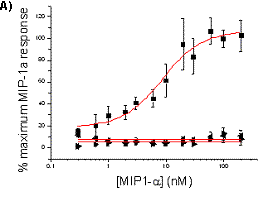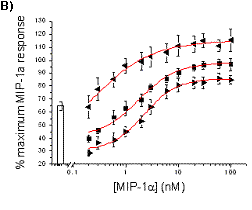| pA2 online © Copyright 2004 The British Pharmacological Society |
113P
University of Newcastle Winter Meeting December 2004 |
The CCR5 antagonist MET-rantes inhibits CCR5-stimulated calcium mobilisation yet promotes receptor internalisation James Longden1,2, Emma-Louise Cooke1, Andy C Hargreaves1 and Stephen J Hill2.1AstraZeneca R&D Charnwood, Loughborough, Leicestershire, LE11 5RH 2Institute of Cell Signalling, Queen’s Medical Centre, Nottingham, NG7 2UH. |
|
The chemokine receptors are members of the G protein-coupled receptor (GPCR) family and predominantly link to Gi/o proteins (Zhao et al. 1998). The ligands for these receptors, the chemokines, are secreted by many cell types to regulate leukocyte activation and recruitment, thus mediating inflammatory responses (Rot et al. 2004). The effect of four reported CCR5 antagonists on MIP-1![]() stimulated calcium mobilisation and receptor internalisation was measured, in order to determine whether their pharmacological effect on clathrin-mediated endocytosis (Aramori et al. 1997) was similar to that of G protein activation.
stimulated calcium mobilisation and receptor internalisation was measured, in order to determine whether their pharmacological effect on clathrin-mediated endocytosis (Aramori et al. 1997) was similar to that of G protein activation.
CHO cells, stably transfected with the CCR5 receptor (tagged on the C-terminus with a Green Fluorescent Protein; GFP), were plated into 96-well Packard ViewPlates two days prior to experimentation (10,000 cells/well in 100 µl of F-12 media with 10% FBS). FBS was removed 24 hours prior to the experiment. Cells were then incubated with 2 µM Fluo-4 for 45 minutes before being washed out and cells treated with antagonist for 30 minutes. Calcium mobilisation was measured on a Molecular Devices FLIPR3. Receptor internalisation assays were performed on an Amersham IN Cell analyser as described previously (Longden et al. 2004).
vMIP-II, met-RANTES (see figure 1A), Eotaxin-3 and MCP-3 were all able to inhibit calcium mobilisation by 100nM MIP-1![]() but had no direct effect on calcium mobilisation. In the internalisation assay, only vMIP-II was able to inhibit the internalisation of CCR5 by 100nM MIP-1
but had no direct effect on calcium mobilisation. In the internalisation assay, only vMIP-II was able to inhibit the internalisation of CCR5 by 100nM MIP-1![]() , shifting the EC50 from 0.9 ± 0.3nM; n=10; to 2.2 ± 0.2nM; n=6; Eotaxin-3 and MCP-3 had no effect. vMIP-II, Eotaxin-3 and MCP-3 had no direct effect on receptor internalisation, however, met-RANTES treatment alone was found to induce internalisation with an EC50 of 34 ± 3nM; n=4. Pre-treatment with met-RANTES for 30 minutes caused a cumulative increase in the MIP-1 a response (see figure 1B). All data are reported as mean + s.e.mean.
, shifting the EC50 from 0.9 ± 0.3nM; n=10; to 2.2 ± 0.2nM; n=6; Eotaxin-3 and MCP-3 had no effect. vMIP-II, Eotaxin-3 and MCP-3 had no direct effect on receptor internalisation, however, met-RANTES treatment alone was found to induce internalisation with an EC50 of 34 ± 3nM; n=4. Pre-treatment with met-RANTES for 30 minutes caused a cumulative increase in the MIP-1 a response (see figure 1B). All data are reported as mean + s.e.mean.
![]()


Figure 1. Effect of antagonists on calcium mobilisation (A) and receptor internalisation (B) by 100nM MIP-1![]() . Each point is the mean ± standard error of the mean for at least 3 experiments.
. Each point is the mean ± standard error of the mean for at least 3 experiments.
In summary, these experiments indicate that met-RANTES inhibits CCR5 mediated calcium mobilisation yet promotes receptor internalisation. In addition, pre-treatment with met-RANTES cumulatively increases MIP-1![]() induced receptor internalisation in a non-competitive manner.
induced receptor internalisation in a non-competitive manner.
Aramori, I. et al (1997) EMBO Journal. 16 (15): 4606-16.
Longden, J. et al (2004) pA2 online, 2 (2). 068P.
Rot, A. & von Andrian, U. H. (2004) Annual Review of Immunology. 22: 891-928.
Zhao, J. et al (1998) Journal of Cellular Biochemistry., 71 (1): 36-45.